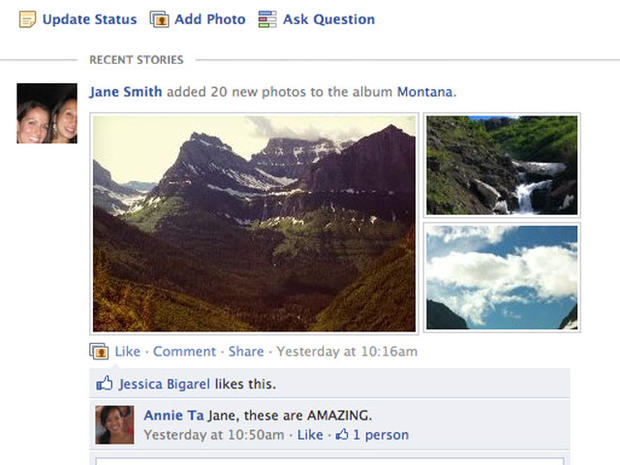Facebook patents stories about online friends
(MoneyWatch) COMMENTARY As Facebook and Yahoo (YHOO) -- and seemingly everyone else in the technology space -- use patent infringement suits as competitive weapons, each new grant from the one of the patent offices becomes an addition to the arsenal. Facebook just received a hefty one from the U.S. Patent and Trademark Office that should help it defend some key features that differentiate it from such competitors as Twitter and Google+.
The name of patent number 8,171,128, granted today, is Communicating a newsfeed of media content based on a member's interactions in a social network environment. Facebook filed for the patent in August 2006 and CEO Mark Zuckerberg is among the listed inventors.
The patent gives the company a strong lock on the ability to let users see not just status messages, pictures, and links to videos of online friends, but also actions those friends take. Those actions could include playing a game or leaving a comment on someone else's post. Facebook now has a strong defense of a critical ability to move beyond an online conversation (Twitter) or set of posts (Google+) and into the realm of leveraging recommendations and influence.
Here's the first independent claim, which helps frame the scope of what Facebook will be able to protect (with a translation to follow, as it's a bit dense):
A method for communicating a social networking system newsfeed based on a user's interactions, the method comprising: storing in a database a user profile for a viewing user of a social network system, the user profile including an identification of a plurality of other users of the social network with whom the viewing user has established a connection; generating a plurality of news stories about one or more other users of the social network system, at least one of the news stories comprising a description about an action taken by at least one of the other users of the social networking system with whom the viewing user has established a connection; generating a newsfeed that comprises a plurality of the generated news stories about the other users of the social network system with whom the viewing user has established a connection, wherein the plurality of generated news stories are selected for the newsfeed based on the viewing user's affinity for content in the news stories; sending the newsfeed comprising the news stories to a user device for display to the viewing user; monitoring one or more interactions of the viewing user of the social network system, wherein the monitored interactions are between the viewing user and at least one of: another user of the social network system, and media content in the social network system; updating the newsfeed to include one or more additional news stories selected based on the monitored interactions, at least one of the additional news stories comprising a description about an action taken by at least one of the other users of the social network system with whom the viewing user has established a connection; and sending the updated newsfeed comprising the selected additional news stories to the user device for display to the viewing user in an order that is based at least in part on the viewing user's affinity for the selected additional news stories.
Now for a clearer explanation of what this covers:
- A database keeps the profile of each person viewing the social network, which is to say, all the users.
- The profile identifies other users with whom the first user has an online relationship.
- The system generates "news stories" about what these connections are doing on the network and then creates a news feed for each viewing user. The system also chooses from among the stories based "the viewing user's affinity" for the content of the stories. It then sends the stories to the user.
- The described system also watches the viewer for actions taken in response to the stories, whether an interaction with another user or with some media content (clicking a like button, sharing, or leaving a comment), and then feeds these new stories back into the pool available for individual news feeds.
As later claims make clear, the media content can come from outside the social network. Users can change preference settings to affect what they see. (If you've ever filtered out all the app announcements that come from someone's activity, you've done exactly that.)
There are further capabilities, as well as some aspects that might potentially disturb privacy advocates. One of the claims explicitly states that an interaction can include what someone does with a received email, which, after all, is another form of media content.
Patenting this aspect of Facebook's functions was a smart business move. One of the features that sets the company's service apart from others is the constantly intertwined updates of users. Some other services have offered related capabilities.
For example, LinkedIn (LNKD) will provide regular updates on what connections have done. Twitter has even started sending out e-mails to users listing items of interest from accounts that a user follows. Even that might be said to encroach on Facebook's patent.
Most importantly, the patent could potentially hobble Google's (GOOG) attempt to expand its social network offering and compete more completely with Facebook.
